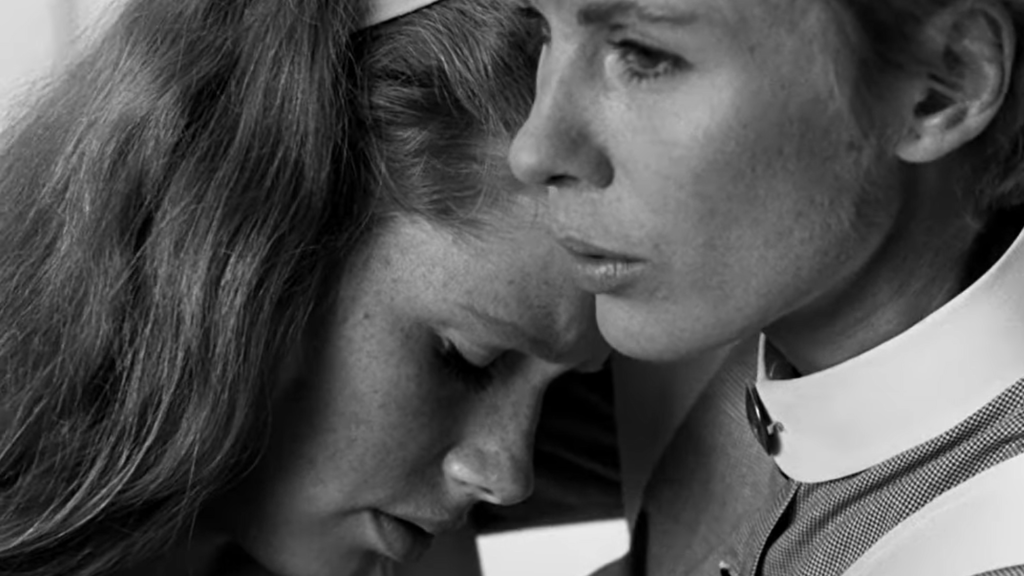Persona
1966

Rated: NR
Genre: Drama, Thriller
Country: Sweden
Run-Time: 1h 23min
Director: Ingmar Bergman
Cast
Babi Andersson……………Alma
Liv Ullmann……………………Elisabet Vogler
Margaretha Krook……….The Doctor
When people list the early masters who have helped shaped the modern horror movement, it’s easy to overlook the contributions of Swedish director Ingmar Bergman. Bergman’s cannon, which includes a number of powerful psychological dramas, have been listed as some of the favourites of many directors, including Stanley Kubrick, Roman Polansky, Wes Craven, Lars von Trier, Ari Aster and Robert Eggers. And though I’ll concede that Hour of the Wolf is Bergan’s only indisputable attempt at making a horror film, the foreboding atmosphere and imagery prevalent in so many films in Bergan’s repertoire, like The Seventh Seal and The Virgin Spring, make them candidates for a re-examination by adult horror enthusiasts.
For example, let’s discuss Bergan’s psychological, drama, thriller 1966’s Persona, a film often described as a pre-Lynchian for its dreamlike cinematography narrative ambiguity. The film begins with a brief montage that includes, among other things, a projector being turned on, a three-frame flash of an erect penis (which was censored in the U.S. and U.K.), a clip from a silent film that includes a materializing man in a devil costume, a tarantula, a lamb being bled and skinned, and a close-up shot of a thick metal nail being hammered into a man’s hand. (But Persona is not outright considered a horror film?) Then, we are taken inside a hospital, or possibly a morgue, where a boy awakes to learn that his bed is pressed up against a screen that has projections of a blurred, enlarged female face. But what do these images, and others, have to do with Persona‘s larger story? Well, that’s all a part of Persona’s charm and its mystery.
Roll opening credits.
Eventually, Persona’s lengthy experimental opening gives way to a more straightforward narrative. Alma (Bibi Andersson), a nurse, is assigned to look after Elizabet Vogler (Liv Ullmann) a famous stage actress who has mysteriously stopped speaking after breaking into laughter on stage while playing Electra. After some time, the doctor concludes that Elizabet’s condition is not due to any physical or mental illness and sends her and Alma to an isolated cottage to help with the actress’s recovery. But things slowly get weird.
Not enough praise can be given to Bibi Andersson and Liv Ullmann for their performances. Ullmann communicates mostly through facial expressions as she must remain completely silent. But Ullmann’s silence means Andersson must convincingly monologue throughout the entire film. Both performances are extremely challenging and have a believability to them that holds up today. It helps to compliment those moments of heightened realism of Bergan’s world. And its completely understandable how this initial setup might lead towards potential disaster. As the woman form a bond, Alma begins to confide more in Elizabet. Elizabet’s isolated retreat starts to gradually double as therapy sessions for Alma, but she requires reassurances of trust from a silent Elizabet, who has revealed nothing of herself, after she confides too much. Essentially, we observe one woman talk herself into mad frenzy when she is supposed to be helping the other recover from a mad, empty silence.
Persona is best known for one specific shot that is a miracle in lighting and cinematography. I don’t want to play spoiler, but I will say that you can the obvious influence in one of the best scenes in Panos Cosmatos’s Mandy.
But for me, the most memorable sequence in Persona comes in the form of long monologue about a sexual encounter delivered by Bibi Andersson that feels so intense, personal, and criminally deviant it edges into the territory of extreme cinema. (The film also includes a clip from a news broadcast showing a man set himself on fire while protesting the Vietnam war.) Interesting enough, Bergman was advised to cut out the monologue, but was convinced to film it anyways by Andersson, who rewrote the dialogue to make it sound more like something a woman would say. Fortunately, Bergman listened and included this scene in the final cut. It’s a good thing too, as this scene is the film’s beating heart.
It is alright if you come out of the Persona confused as to what it all means. Author and film critic Peter Cowle once famously wrote that “Everything one says about Persona may be contradicted; the opposite will also be true.” Bergman was at a point in his career where he allowed the narrative to move forward with a dream logic, revealing the nightmarish images and sequences he had on his mind. We see this same style of filmmaking play itself out in his next film, Hour of the Wolf, as well. It is not unlike watching the films of Kiyoshi Kurosawa, where scenes make sense on their own, but don’t easily fit together when you look at the work as a whole. Many words have already been written about Persona’s use of identity as a theme and its vampiric undertones, so much so that I have little I wish to add to this conversation. However, I do feel compelled to add that each woman has aspects that the other secretly wishes to be and their time at the cottage proves a cathartic process.
Over time, it has been increasingly clear that adult-themed horror has roots in many of Ingmar Bergam’s films. Persona is a must-watch film for anybody interested in seeing how horror has developed in cinema over the years. It is a mature unformulaic psychological thriller that at times makes the content in Polansky’s groundbreaking Repulsion, released only a year earlier, almost feel quaint by comparison. The film has a truly timeless feel and the juxtaposition of hyperrealism with surrealism has rarely been better balance. In short, this film is a masterpiece.
